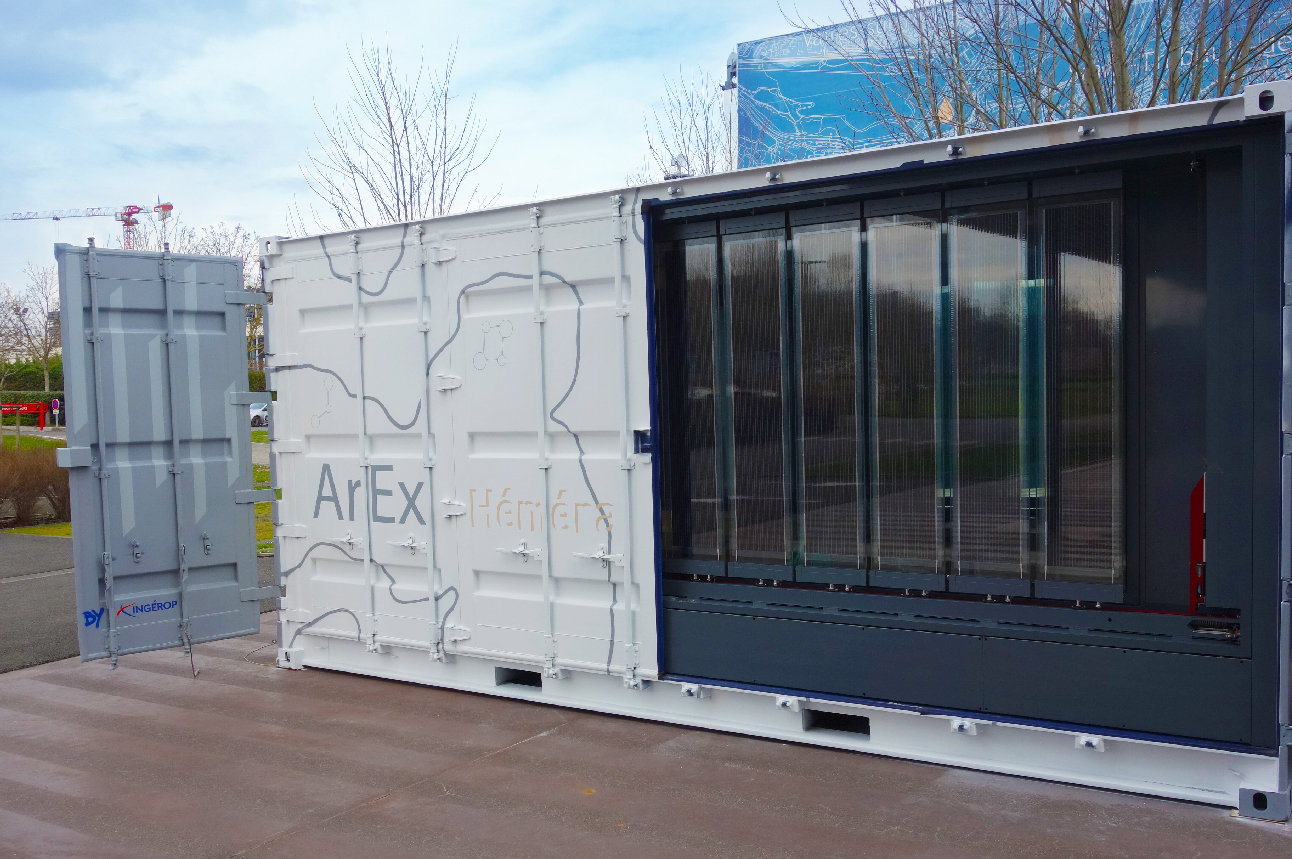After 3 years of research, Arcora presents Héméra, a new silent, compact, and autonomous system, developed with researchers from the Navier laboratory at École des Ponts ParisTech. It is the first solar shading system actuated by a shape memory alloy wire. This development aligns with Arcora’s ambition to offer responsible technical solutions while providing architectural benefits, and meets growing and legitimate environmental demands, reflected notably by the arrival of the RE2020 regulations.
At a time when protecting the planet is an absolute imperative, Arcora sees respect for the environment as a driving force for creating more responsible alternatives. Emmanuel Viglino, Director of Arcora, comments: “We are beginning a new chapter in Arcora’s research and development approach by taking on the ambitious scientific and technical challenge of designing a high-performance, sustainable, and silent solar shading system. Héméra thus allows us to develop industrial competence, evolve architecture with a compact system, while fostering the environmental transition.”
SMA – A Single Wire to Actuate an Entire System
Composed of a nickel-titanium (NiTi) alloy, Shape Memory Alloys (SMA) are frequently used in the biomedical industry (implants, orthopedic staples, wires for orthodontic appliances, kidney stone baskets, or stents), or in watchmaking as springs in watch mechanisms. These alloys possess two exceptional properties: super-elasticity, which can reach ten times that of steel, and shape memory, as they have the capacity to return to their initial shape, meaning they “remember” the thermomechanical treatments they have undergone. Their exceptional properties were the subject of a thesis conducted since 2015 by Philippe Hannequart, PhD and R&D Officer at Arcora, which led to Héméra, a mobile solar shading system with louvers actuated solely by the force of the shape memory alloy wire, stimulated by external temperatures. The system is energy-autonomous thanks to louvers equipped with ASCA® photovoltaic films composed of organic polymers. Emmanuel Viglino specifies: “We are convinced that implementing virtuous solar shading systems is an essential condition for limiting carbon footprint while guaranteeing user comfort. The addition of photovoltaic louvers is a considerable asset for the system’s energy autonomy.”
Research Support and Guidance
Jean-François Caron, Michael Peigney, and Olivier Baverel, researchers at the Navier laboratory, supported Philippe Hannequart throughout his research work as part of his thesis hosted by Arcora and supported by the Ingérop group within its innovation initiative. Philippe Hannequart comments: “Curiosity and the desire to understand the properties of the shape memory alloy and its effects brought Arcora and the Navier laboratory together, and this collaboration allowed us to increase our knowledge and concretely envision its application.”
Moving from research to industrial application was a challenge met thanks to the pooling of research conducted with the Navier laboratory team, Arcora’s support throughout the thesis, and the expertise of Wicona, a designer-manufacturer specializing in aluminum façade and joinery construction systems. Philippe Hannequart adds: “Thanks to Wicona, we were able to evaluate the proof of concept through a concrete application. This is proof of the essential nature of engineering in resolving current environmental challenges, and this effort must be deployed more broadly to contribute to a more sustainable world.”
ArEx – User Comfort Assessment
Arcora set up ArEx, a shipping container, to present the Héméra system regardless of its exhibition location, while evaluating user comfort. The container was redesigned with the aim of offering a pleasant demonstration space while rationalizing carbon impact. Indeed, in addition to the dynamic solar shading system, visitors’ hygrothermal comfort is ensured by a reversible heat pump, a linear diffuser (Koolair DF-47 type), and a battery recharged by the photovoltaic production of the louvers, which powers all equipment. Arcora’s teams chose to optimize design and layout solutions to reduce the carbon footprint. Thus, façade elements provided by Wicona are made of recycled aluminum, the interior parquet comes from reused windows from a school located in La Courneuve (93), and finally, a natural ventilation system regulates the interior temperature for maximum user comfort, regulated by an energy-autonomous system.
A Committed Carbon Approach
Thanks to its partnership with École des Ponts ParisTech, Arcora reinforces its commitment to offering responsible solutions for a better shared future. Aware of the environmental urgency, Arcora takes its role as a designer of the transition toward more sustainable buildings to heart, and Héméra-ArEx is fully in line with our commitments. Furthermore, for several years, Arcora has developed a carbon weight calculation tool taking into account the numerous data points of the façade package to assess impact as accurately as possible. “In Arcora’s DNA, with over 45 years of experience, there is a will to be a driving force in technical design solutions. We are aware that it is urgent to respond to climate change challenges, which is why, well before the RE2020, we decided to act to reduce the impacts of our solutions and contribute to a virtuous environment. Our model relies on a long-term vision that stimulates innovation and excellence—drivers of Arcora’s success—allowing us to enrich our multi-criteria approach to performance and support our partners in developing more virtuous projects, notably with a reasoned use of wood in façade and envelope design.”
Click here to read the full article.
To learn more, the presentation file is available here
